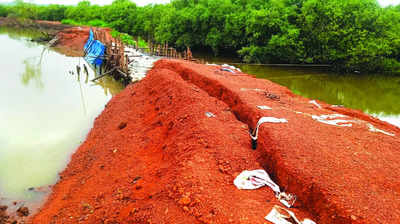Trending
Repaired Carambolim bundh caves in, fear of inundation floods village

The bundh repair had been carried out by the soil conservation division of the agriculture department through a contractor at a cost of Rs 5 crore earlier this year.
Earth (red mud) had been dumped over an age-old traditional clay bundh and a retaining wall had been built to keep the filling in place.
But portions of the bundh started collapsing even during construction, as trucks had to move over the completed portion to transport earth for the extension.
“Several houses at Dhado-Dongri, Patto, and Copem (in southeastern Carambolim) are in danger of being flooded as the bundh appears weak,” a villager said.
The village’s thickly populated stretches with three-fourths of agricultural land in the biggest Tiswadi khazan have habitations on the edge of fields. “Though 70% of Carambolim’s land is agricultural, most of it has been submerged for nearly two decades,” a farmer said.
No agricultural activities have been possible due to breaches and fragile condition of the main bundh — a protective barrier between the Cumbharjua canal and the khazan lands from Agasaim to Banastarim and beyond.
“The Kuvoll-Kator bundh is part of the network of sluice gates and waterbodies called Panch Manos,” the farmer said. “If it rains heavily for days, the bundh with cracks may collapse and the flood level may rise in low areas.”
The collapse of a bundh stretch in mid-June sparked a debate among locals over the quality and methodology of repairs. “The mud was not properly compacted before building a retaining wall, which could have had a deeper foundation,” another resident said.
The agriculture department has taken note of the villagers’ concerns. “The contractor has carried out preventive measures on our direction,” an official said.
Trucks carrying mud during repairs also caused the flattening of the bundh. “The contractor could have waited to build the retaining wall. However, he tried to keep to the deadline,” the official said.
But he said that the contractor is tied by a two-year maintenance clause to carry out repairs at his own cost.
Both construction material and construction technique need special attention in the context of sustainable practices, Elsa Fernandes, an environmental architect said. “These should be made options in standard designs for khazan areas or the arbitrary approach currently used will drain resources — of finance and biodiversity,” she said.
End of Article
FOLLOW US ON SOCIAL MEDIA










